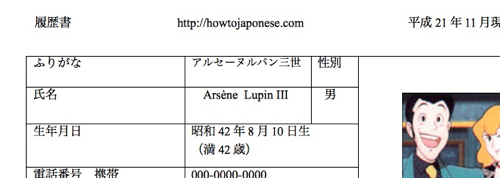Japanese résumés, unlike American résumés (and I assume other Western résumés), follow a rigid format. They sell special résumé paper here that is gridded into different categories. Applicants fill them out by hand in their prettiest handwriting and stick on a photograph of themselves.
If you have confidence in your kanji skills and a ton of free time, you might consider filling yours out by hand – that would have to be really impressive to anyone looking to hire. I myself couldn’t be asked, so I created a résumé in Word using tables. It covers all of the basic categories and was relatively easy to edit. I’ve edited it into a mock résumé for Lupin III and uploaded it here. Feel free to download it and adapt it for your own uses. I originally created the file in Word but have been editing it in Open Office, so I apologize if the formatting is a little finicky. If it comes in handy for you, send me your success story.
A couple of interesting differences with an American résumé:
– Japanese use photos on their résumés. You will go far if you are tall, dark, and handsome with striking sideburns.
– Japanese put their date of birth, age and sex on résumés. Too many X chromosomes, and you may be serving tea.
– A lot of people list their hometown and parents. I was encouraged to do this by a teacher I was working with. This could be especially effective for foreigners because katakana may help with the pronunciation of difficult city names.
– There is a lot of what they call 自己PR (literally “self public relations”) that goes on with résumés and also job hunting in general. It reminds me of the pep rallies at the junior high school where I taught. The teams lined up individually and the kids had to give a self-introduction. They go down the line one by one and say a little sentence about themselves: “Hello, I’m Taisuke in the second year. I will do my best at the tournament and run as fast as possible.” The kids all vary their statements slightly (“I will give my best effort.” “I won’t ever give up.” etc.), and I always felt bad for the last guy because all the good words had been taken! 自己PR is kind of like this, but you have to say what your strong points are. I always felt like it was a load of crap. To give you an idea, here’s what I use on my actual résumé: ひとつのことにこだわらずに、いろいろな角度で物事を考え、見て、行動できることです。そのときの状況を踏まえて行動できるからこそうまくいきます。Basically I have a short attention span and am good at extemporaneous bullshitting. And remember, those words are mine – you’re next in line, so get your own!
– While the document is two pages, Japanese résumés are double-sided, so this is actually a one-page résumé. Always print them on one page.
Enjoy!

